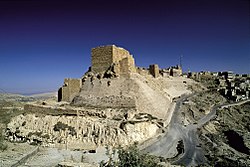Helena of Milly (died circa 1167), was a Frankish noblewoman who was the lady of Transjordan [1] in the Kingdom of Jerusalem from 1166 to her death around 1167.
Helena was the elder daughter of the lord of Nablus, Philip of Milly, and his wife Isabella (Elizabeth). Helena and her siblings, Stephanie and Renier, were all born by 1153. [2] In 1161 Helena's father ceded his lands in Nablus to King Baldwin III and received the lordship of Transjordan in return. [3] Transjordan was one of the greatest fiefs in the crusader kingdom. [4] Among the numerous prominent witnesses to this act were Humphrey III of Toron, who married Stephanie, and Walter III Brisebarre of Beirut, who married Helena. [5]

Helena married Walter Brisebarre probably before 1164, when Walter was still lord of Beirut. [6] They had one child, a daughter named Beatrice. [7] Helena's father, Philip, relinquished the lordship of Transjordan and entered the Order of the Temple in 1166. Her only brother, Renier, had presumably died childless by that time. [8] [7] The custom of the kingdom at that time did not yet prescribe the equal division of a fief among daughters if the fiefholder had no sons, and so Helena enjoyed the same rights as an eldest son and inherited the entire fief jointly with her husband, Walter. Historian Bernard Hamilton argues that Walter's cession of Beirut to the crown at this time was a condition imposed by King Amalric to prevent the merger of two great fiefs. [7]
Helena had died by 18 November 1167, when Walter issued a grant to the Order of Saint Lazarus for the repose of her soul. [9] [7] Her death undermined Walter's position in Transjordan. He continued to rule the lordship but only as the bailli for his and Helena's daughter, Beatrice. [7] By 1174, Beatrice too had died, and the fief passed to Helena's younger sister, Stephanie. [10]